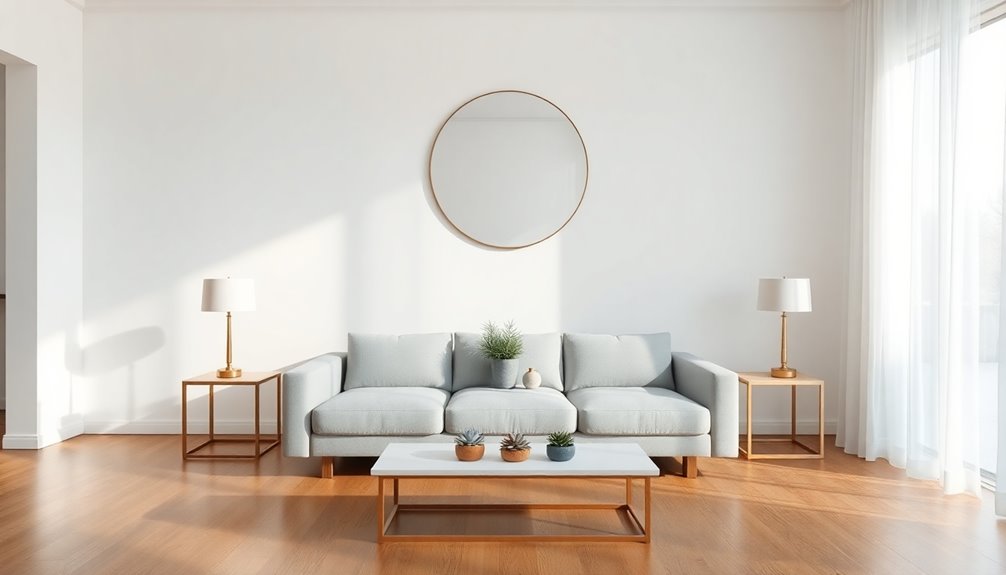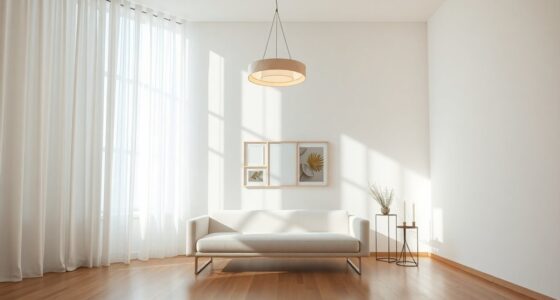Balancing minimalist symmetry in home decor involves creating a space that feels calm and inviting. Start by choosing a cohesive color palette of soft neutrals and arranging paired elements around a focal point. Incorporate negative space to highlight each piece and mix textures for depth without clutter. Keep decorative items minimal yet impactful, and use soft, diffused lighting to enhance the atmosphere. Want to uncover more about enhancing your space's serenity? Keep exploring!
Key Takeaways
- Choose a cohesive color palette of soft neutrals to create a spacious and calming environment.
- Arrange matching furniture and decor in symmetrical pairs around a central focal point for visual stability.
- Incorporate negative space to highlight individual pieces and enhance the overall tranquility of the space.
- Mix textures, such as soft fabrics and smooth surfaces, to add depth while maintaining a minimalist aesthetic.
- Use strategic lighting to enhance symmetry and warmth, creating an inviting atmosphere in your home.
The Essence of Minimalist Symmetry in Home Decor

When you embrace minimalist symmetry in home decor, you create an environment that radiates tranquility and order. This approach emphasizes balance, using clean lines and a clutter-free aesthetic to enhance the visual appeal of your space.
By opting for a limited color palette with neutral tones, you maintain simplicity while expanding the feeling of spaciousness. Symmetrical arrangements, like evenly placed furniture or matching decor, evoke stability and formality, which are integral to minimalist interiors.
Remember to incorporate negative space, allowing breathing room around objects to foster a serene atmosphere. Additionally, introducing natural materials and textures can add warmth and character, all while adhering to the minimalist principle of keeping your decor simple and functional. Incorporating durable materials can also help maintain the minimalist aesthetic while ensuring longevity in your design choices.
Key Elements for Achieving Balance
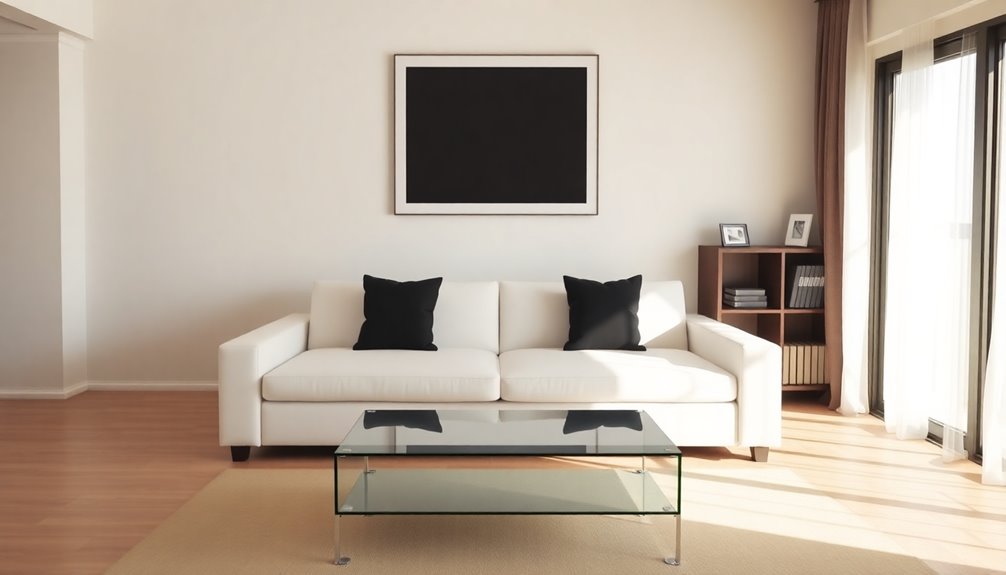
To achieve balance in minimalist decor, focus on selecting key pieces that resonate with a cohesive color palette and enhance visual harmony. Use symmetry by arranging matching items on either side of a focal point. This creates a structured aesthetic while allowing for asymmetry through varied heights of decor elements, adding visual interest. Don't forget to incorporate negative space; it's essential for letting the eye rest and highlighting each piece's elegance. Additionally, choose materials intentionally, combining smooth surfaces with soft fabrics to create depth and contrast. Mindful decluttering of excess items can also help in achieving a tidy environment, promoting a serene atmosphere that complements your minimalist decor.
| Element | Effect |
|---|---|
| Matching Lamps | Creates symmetry |
| Tall Plants | Adds vertical interest |
| Soft Fabrics | Introduces warmth |
| Clean Lines | Enhances simplicity |
| Negative Space | Provides breathing room |
Strategies for Incorporating Paired Elements
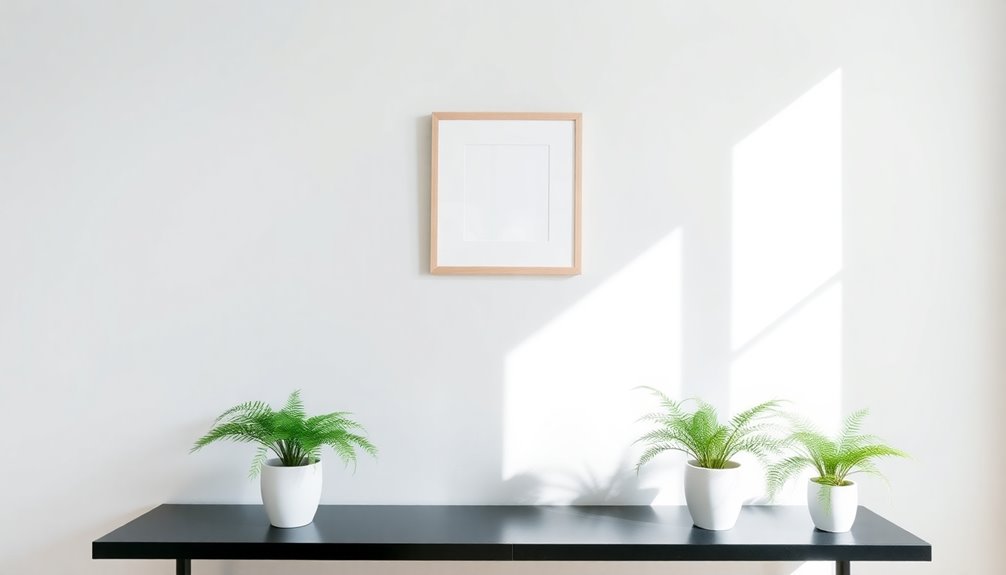
Incorporating paired elements can considerably elevate the symmetry in your minimalist decor, creating a sense of order and tranquility.
Start by utilizing matching furniture, like identical nightstands or chairs, to achieve a cohesive look that enhances visual balance. Place paired decorative elements, such as lamps or vases, on either side of a central focal point to reinforce this balance while maintaining a clean aesthetic.
Utilizing matching furniture and paired decorative elements fosters visual balance and a cohesive minimalist aesthetic.
Opt for simple, streamlined shapes to align with minimalist principles, ensuring they don't overwhelm the space. A limited color palette for these paired elements promotes harmony and keeps the decor uncluttered.
Position your items at equal distances from a central axis to establish a clear visual line, enhancing overall symmetry and adding visual intrigue to your space. Additionally, consider the importance of functional layout to ensure that each element serves a purpose while contributing to the overall aesthetic.
Enhancing Serenity With Color and Texture
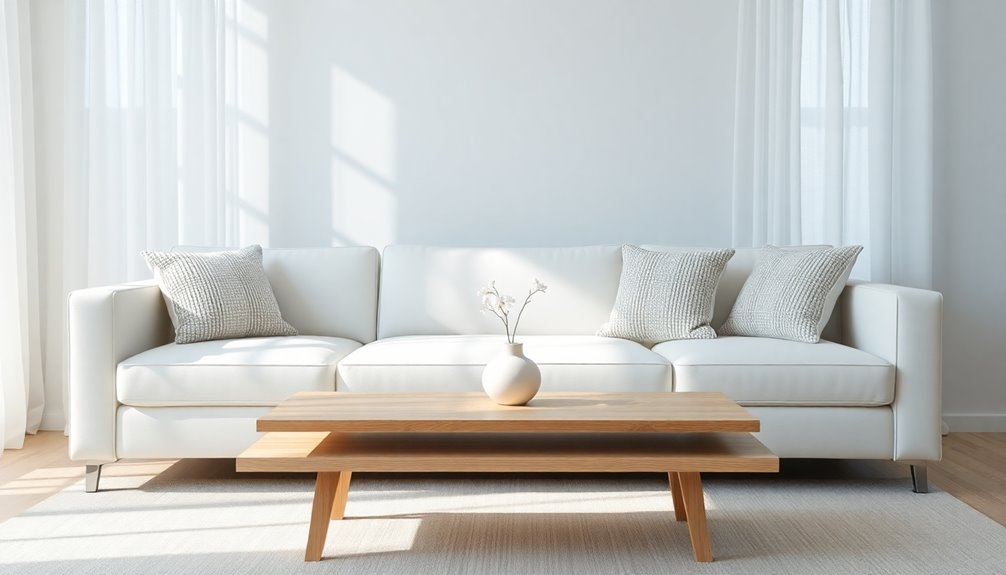
While a minimalist space often emphasizes simplicity, the right use of color and texture can transform it into a serene sanctuary. Start by choosing a calming color palette of soft neutrals like whites, beiges, and light grays. Mix in varying textures—think smooth leather chairs with plush wool throws—to add depth without cluttering the visual field. Use accent colors sparingly to create focal points that enhance symmetry. Incorporate natural materials like wood and stone for tactile contrast and visual interest. Finally, pay attention to lighting; soft, diffused lighting fosters a tranquil ambiance, highlighting both the textures and colors in your minimalist decor. The use of natural materials in your space not only enhances visual weight but also connects the decor to the surrounding environment.
| Element | Purpose |
|---|---|
| Color Palette | Creates a serene atmosphere |
| Natural Materials | Adds visual weight and depth |
| Lighting | Enhances textures and colors |
Tips for Maintaining an Inviting Atmosphere
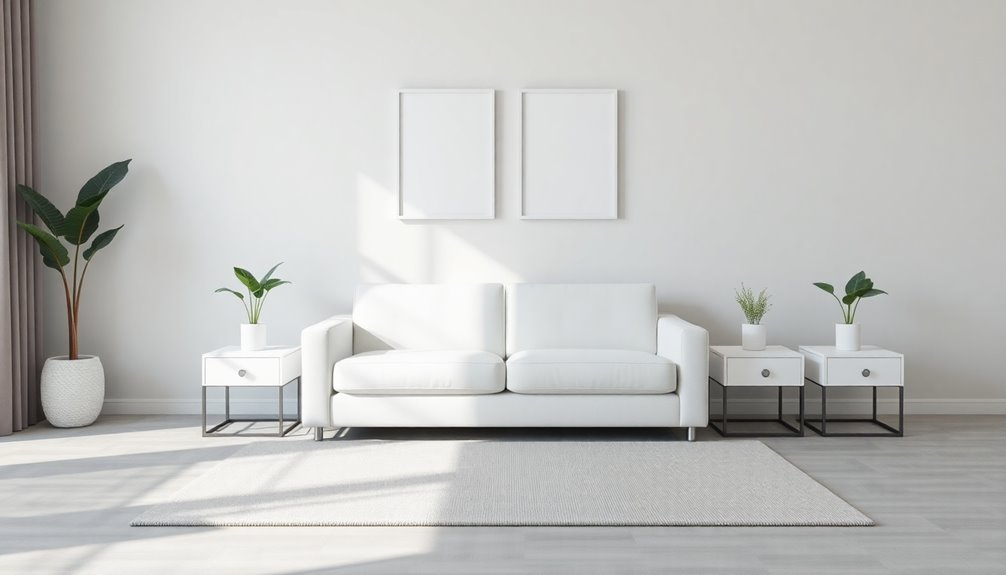
How can you maintain an inviting atmosphere in a minimalist space? Start by choosing a limited color scheme of soft, neutral tones to create a sense of calm and balance.
Use strategic lighting, like warm-toned floor lamps, to enhance symmetry and add a cozy feel.
Strategic lighting with warm-toned floor lamps creates a cozy ambiance while enhancing the symmetry of your minimalist space.
Arrange your furniture pieces in symmetrical pairs around focal points, such as a coffee table, to encourage conversation while maintaining visual weight.
Integrate natural elements like greenery or wooden textures to infuse warmth without overwhelming the minimalist design.
Finally, keep decorative items minimal; select a few impactful pieces that reflect your personal style. Additionally, consider incorporating multifunctional furniture to maximize both comfort and space efficiency in your decor.
This approach will help you achieve a harmonious, inviting atmosphere that embodies the essence of minimalism.
Frequently Asked Questions
Can Minimalist Symmetry Work in Small Spaces?
Absolutely, minimalist symmetry can work wonders in small spaces!
By using furniture and decor that mirror each other, you create a sense of balance without overwhelming the area. Choose light colors and sleek lines to maintain an airy feel.
Incorporating functional pieces, like dual-purpose furniture, maximizes space efficiency.
Don't shy away from using art or decor with symmetrical designs, as they can enhance the overall aesthetic while keeping things uncluttered and visually appealing.
How Do I Choose Paired Elements for My Decor?
Choosing paired elements for your decor is like finding a perfect dance partner; they should complement each other effortlessly.
Look for items that echo your style while maintaining harmony—think matching vases or artwork. Balance is key; one shouldn't overpower the other.
Consider scale and color; they should resonate together, creating a cohesive look. Trust your instincts, and don't hesitate to mix textures; it adds depth and interest to your space, making it truly inviting.
What Furniture Styles Complement Minimalist Symmetry?
To complement minimalist symmetry, you'll want to choose furniture styles that emphasize clean lines and simplicity.
Think about Scandinavian design with its functional yet elegant pieces, or mid-century modern, which offers a timeless appeal.
Additionally, consider contemporary styles that incorporate geometric shapes. Pairing these styles with neutral colors helps maintain a cohesive look.
Are There Any Specific Colors to Avoid in Minimalist Decor?
Why clutter your space with colors that scream for attention?
In minimalist decor, you'll want to avoid bold colors like bright reds or neon greens, as they disrupt the calm and cohesive vibe.
Instead, stick to neutral tones like whites, grays, and soft pastels that create a serene atmosphere.
How Can I Add Personal Touches While Maintaining Symmetry?
To add personal touches while maintaining symmetry, think about incorporating items that reflect your personality but keep them in pairs or balanced arrangements.
Use art pieces, plants, or decorative objects that match in size and style. You can also choose a color palette that resonates with you, ensuring it complements the overall aesthetic.
Small, meaningful items, placed thoughtfully, can enhance the space without disrupting the harmonious feel you're aiming for.
Conclusion
Embracing minimalist symmetry in your home decor is like crafting a serene symphony, where each element plays its part in harmonious balance. By thoughtfully pairing items and infusing soothing colors and textures, you create a tranquil sanctuary that invites warmth and comfort. Remember, it's not just about the absence of clutter; it's about the presence of peace. So, take a step back, breathe in the beauty, and let your space reflect the calm rhythm of your life.
